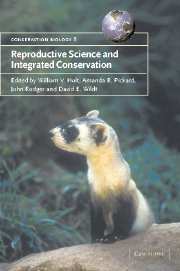Book contents
- Frontmatter
- Contents
- List of contributors
- Foreword
- Part I Introduction
- Part II Reproduction and population viability
- Part III Reproductive techniques for conservation management
- 9 Reproductive and welfare monitoring for the management of ex situ populations
- 10 Non-invasive endocrine measures of reproduction and stress in wild populations
- 11 Ultrasound for analysis of reproductive function in wildlife species
- 12 Role of embryo technologies in genetic management and conservation of wildlife
- 13 Application of nuclear transfer technology to wildlife species
- Part IV Integrated conservation management
- Part V Reproduction science in non-mammalian species
- Part VI Conclusions
- Index
- References
10 - Non-invasive endocrine measures of reproduction and stress in wild populations
Published online by Cambridge University Press: 21 January 2010
- Frontmatter
- Contents
- List of contributors
- Foreword
- Part I Introduction
- Part II Reproduction and population viability
- Part III Reproductive techniques for conservation management
- 9 Reproductive and welfare monitoring for the management of ex situ populations
- 10 Non-invasive endocrine measures of reproduction and stress in wild populations
- 11 Ultrasound for analysis of reproductive function in wildlife species
- 12 Role of embryo technologies in genetic management and conservation of wildlife
- 13 Application of nuclear transfer technology to wildlife species
- Part IV Integrated conservation management
- Part V Reproduction science in non-mammalian species
- Part VI Conclusions
- Index
- References
Summary
INTRODUCTION AND OBJECTIVE
The evaluation of steroid metabolite content and/or profiles in either urine or faeces represents a snapshot of hormone activity and permits the long-term study of reproductive patterns in individuals, populations or species, all without perturbing the animal. By the mid-1980s, non-invasive immunoassay analysis of urine, which was pioneered in captive non-human primates (Hodges et al., 1979), had been adopted for the ex situ reproductive study of diverse primate, ungulate and avian species. Steroid monitoring in faeces was first described in the human (Adlercreutz & Martin, 1976) and then applied to the domestic mare (Bamberg et al., 1984) and cow (Möstl et al., 1984), before being used in the first non-domesticated species, the macaque (Risler et al., 1987). The non-invasive measurement of adrenal hormone metabolites was first accomplished in the bighorn sheep (Miller et al., 1991). These technological breakthroughs have revolutionised wildlife endocrinology.
Similar strategies using either urine or faeces also have application to free-living wildlife. The first study was reported in 1984 and investigated musth in male African elephants (Poole et al., 1984). Shortly thereafter, followed a study of female vervet monkeys (Andelman et al., 1985). Since then, more than 50 publications (Table 10.1) have described non-invasive endocrine monitoring of free-living mammals and birds. These studies have assessed longitudinal reproductive patterns (including seasonality, ovarian cyclicity and pregnancy), but more often have evaluated fecundity or hormonal relationships in ‘social’ species.
- Type
- Chapter
- Information
- Reproductive Science and Integrated Conservation , pp. 147 - 165Publisher: Cambridge University PressPrint publication year: 2002
References
- 7
- Cited by

